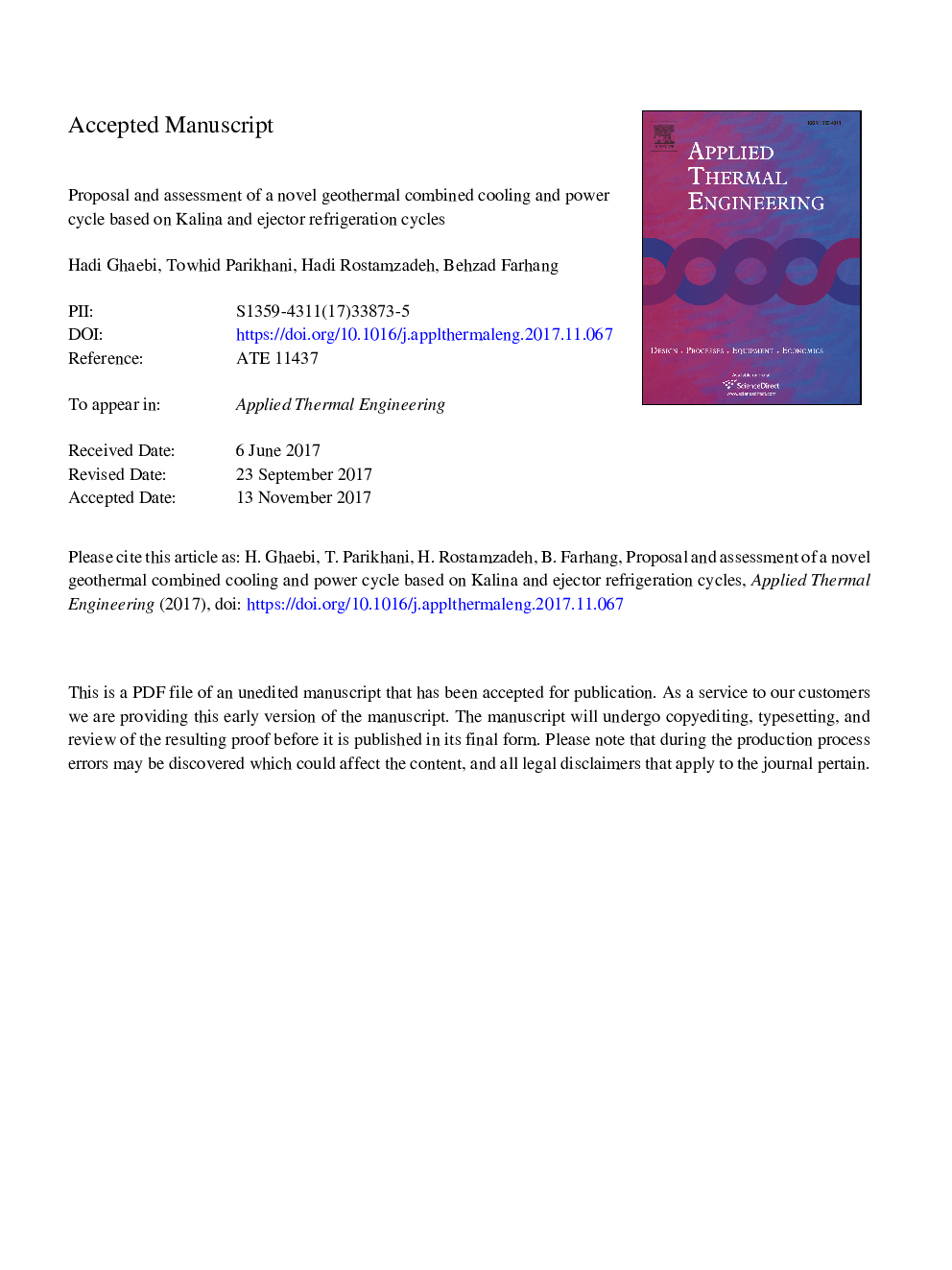| کد مقاله | کد نشریه | سال انتشار | مقاله انگلیسی | نسخه تمام متن |
|---|---|---|---|---|
| 7046443 | 1457099 | 2018 | 54 صفحه PDF | دانلود رایگان |
عنوان انگلیسی مقاله ISI
Proposal and assessment of a novel geothermal combined cooling and power cycle based on Kalina and ejector refrigeration cycles
دانلود مقاله + سفارش ترجمه
دانلود مقاله ISI انگلیسی
رایگان برای ایرانیان
کلمات کلیدی
موضوعات مرتبط
مهندسی و علوم پایه
مهندسی شیمی
جریان سیال و فرایندهای انتقال
پیش نمایش صفحه اول مقاله

چکیده انگلیسی
This paper aims at introducing a new combined cooling and power (CCP) cycle, using geothermal energy as low-temperature heat source. The proposed cycle is integrated from a Kalina cycle (KC) and an ejector refrigeration cycle (ERC) to produce a simultaneous refrigeration and power outputs. To enhance performance operation of the proposed CCP cycle, turbine exhaust is extracted for more power production purposes by employing a feed fluid heater (FFH). Energy and exergy assessments of the proposed CCP cycle are conducted using Engineering Equation Solver (EES) software. In addition, considering the thermal efficiency and exergy efficiency as objective functions, single- and multi-objective optimizations are carried out by genetic algorithm (GA), leading to determination of the optimum design variables including basic ammonia concentration, geothermal inlet temperature, evaporator temperature, turbine inlet pressure, mass extraction ratio (MER), FFH pressure, terminal temperature difference (TTD) of vapor generator, and pinch point temperature differences of vapor generator and recuperators. In this case, the optimum net output power, refrigeration, thermal efficiency and exergy efficiency are calculated 2319â¯kW, 1133â¯kW, 15% and 47.8%, respectively. Moreover, among all components condenser 1 accounts for the biggest exergy destruction rate (589.6â¯kW) followed by vapor generator (422.1â¯kW). To better understand the effect of various parameters on system performance, a comprehensive parametric study of some key parameters (including turbine inlet pressure, geothermal inlet temperature, feed fluid heater pressure, evaporator temperature, basic ammonia concentration, and mass extraction ratio) on the performance criteria is carried out. It is shown that the exergy efficiency of system can be maximized based on the turbine inlet pressure, feed fluid heater pressure, basic ammonia concentration, and mass extraction ratio. In addition, the thermal efficiency of system can be maximized by feed fluid heater pressure, while refrigeration output can be maximized by mass extraction ratio. Also, it is shown that a higher power output can be obtained at lower turbine inlet and feed fluid heater pressures as well as higher geothermal inlet temperature, basic ammonia concentration, and mass extraction ratio. Moreover, a higher refrigeration output can be resulted at higher turbine inlet pressure and evaporator temperature, as well as lower feed fluid heater pressure and basic ammonia concentration.
ناشر
Database: Elsevier - ScienceDirect (ساینس دایرکت)
Journal: Applied Thermal Engineering - Volume 130, 5 February 2018, Pages 767-781
Journal: Applied Thermal Engineering - Volume 130, 5 February 2018, Pages 767-781
نویسندگان
Hadi Ghaebi, Towhid Parikhani, Hadi Rostamzadeh, Behzad Farhang,